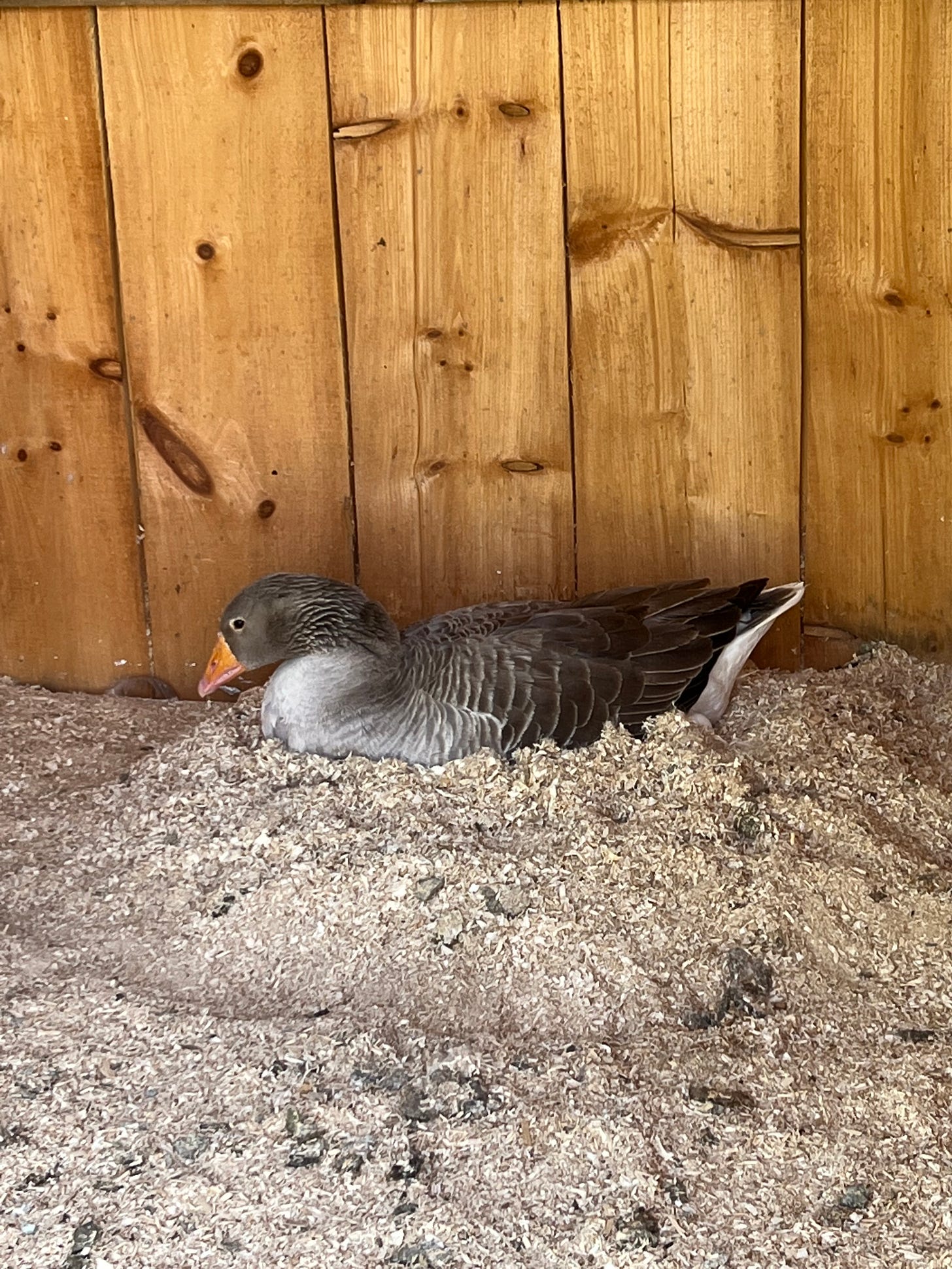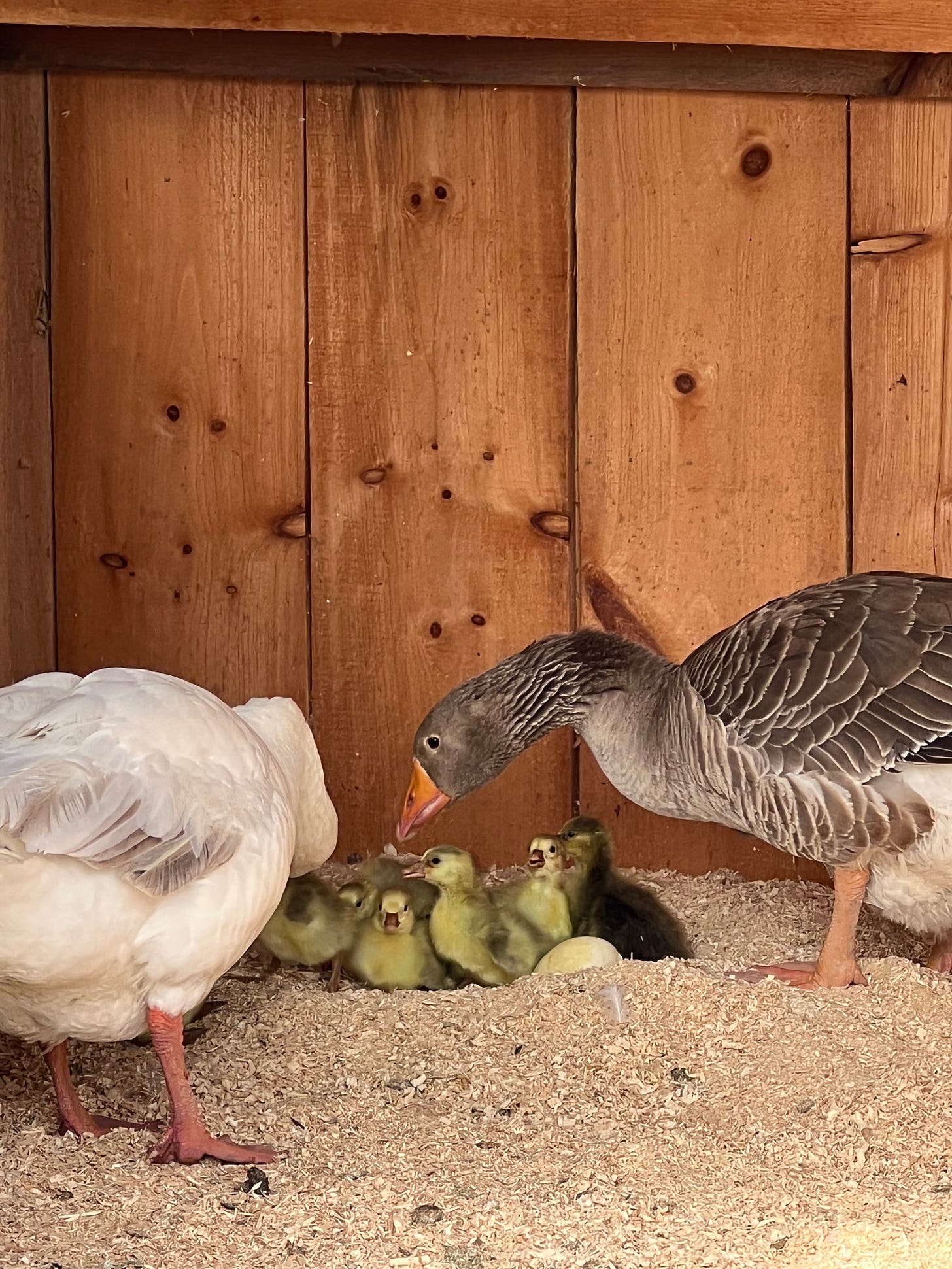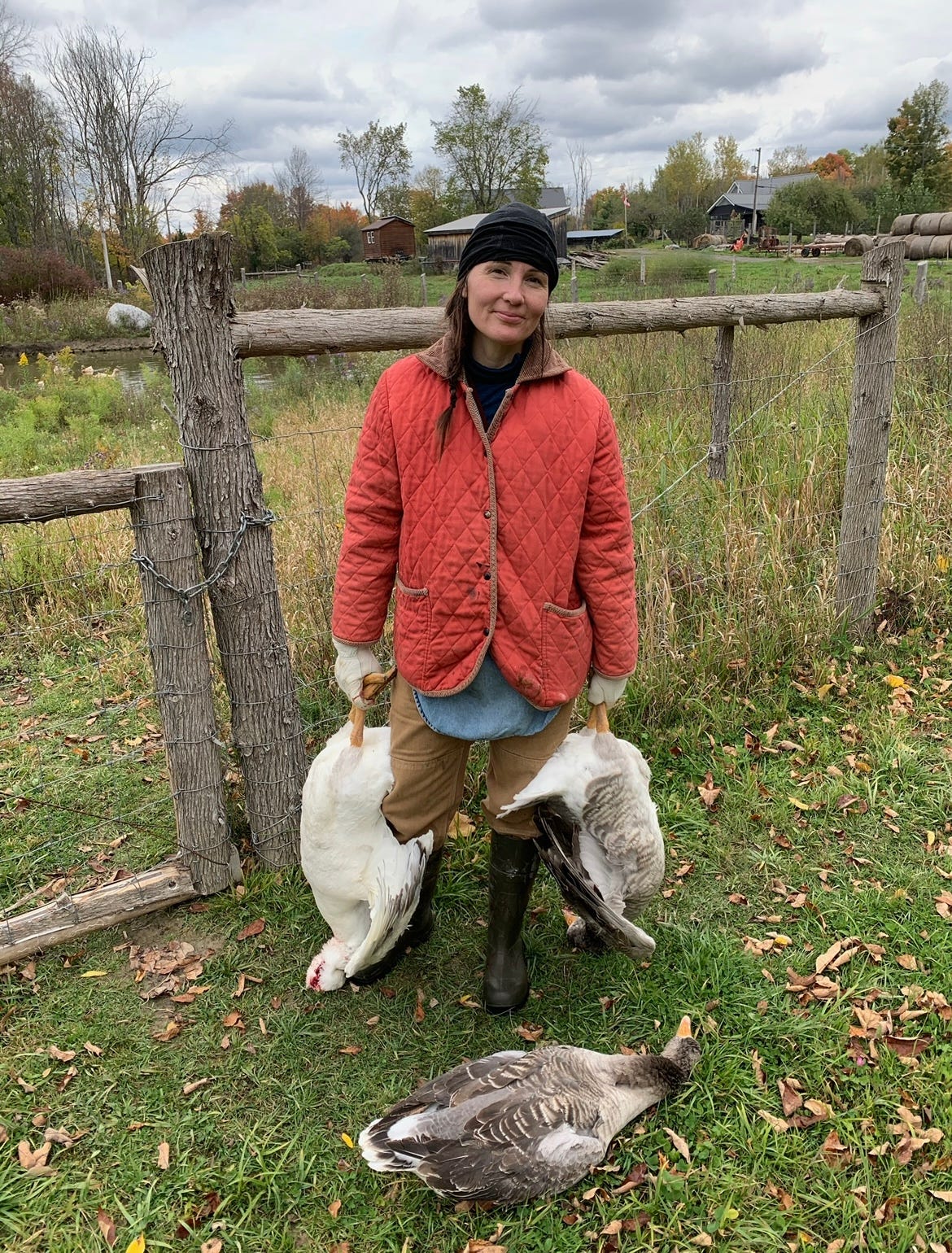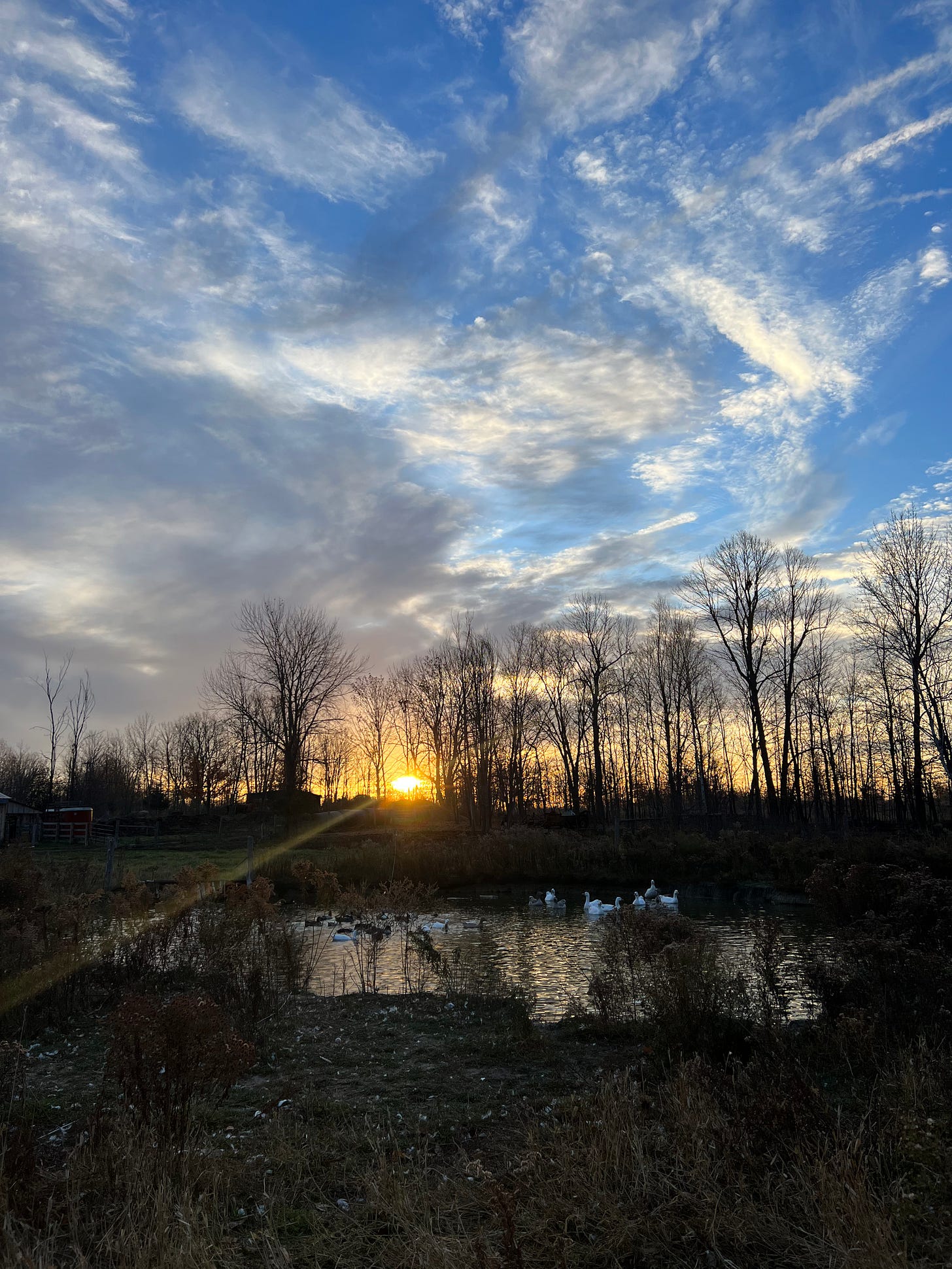Note to paid subscribers: As I’m away from home, I have no access to a microphone. The audio versions of my essays will return when I do. 😉
Last week I found myself wrapping the bodies of dead geese in red butcher paper. That’s my job - the wrapping, and I do my best to wrap the bodies of all of the animals we harvest with ceremony and care. It is a gift that will be unwrapped in celebration one day and a gift should always evoke excitement at the possibilities that lay beyond its shrouded mystery.
The geese I was wrapping were the goslings born earlier this spring. Born to Harold and Maude, our beautiful Pilgrim pair. Pilgrim geese, like all geese, mate for life. Sometimes a second female can be thrown into the mix with ease. I suspect Maude would have none of that. She’s a serious goose, a “no tomfoolery” kinda’ goose. For ten years now Harold and Maude have lived, side by side. Every spring she lays beautiful, enormous eggs with shells like hardened plaster. We steal some to poach in puddles of spring’s sweet butter before she really starts getting serious about the endeavour. When she does get serious, we hear about it. “No more eggs for you!” she yells and her trusty, loyal Harold enforces her demands with a charging hiss aimed at our ankles.
Harold’s courage is more an agreement between us than it is an actual character trait. He’s devoted to his gal and, when the babies come, he is tirelessly devoted to them too. Often, while he patiently waits for Maude during the weeks she remains trance-like on her mound of eggs, he can be seen swimming in the pond alone with the ducks. Desperately, ole Harold tries to use his instinctual prods to protect the newly hatched ducklings, usually born a week or two before the goslings will appear, much to the dismay of their mothers. The ducks aren’t impressed by Harold’s parental offerings, but what’s a guy to do when all systems are in protect mode and such tiny, vulnerable floating fluff balls paddle by? We never do lose ducklings to hawks or eagles.
When the goslings do arrive, cracking into the world one by one, the triumphant Maude appears, regaling the entire county with her exalted announcements. Harold opens his huge wings, enormous head lurched forward on his thick, powerful neck. “MINE!” he shrieks at the ducks and dogs and swaying shrubs. “MINE” he squawks at the humans and the sheep and the useless coyotes the humans call “dogs”. Maude and Harold now irrevocably tied to the sweet, rotund bellied, peeping gaggle of inseparable little creatures, yellow and soft and irresistibly, painfully, syrupy sweet. “MINE” Harold yells at the ducklings he once used as surrogate kids, but has now dropped like hot potatoes. He’s got the good stuff now. No need for dumb ducklings.
The goslings remain with Harold and Maude for the entirety of their lives. Every morning they are released from their house and they come out squawking and rejoicing for their freedom. They head straight to their food dishes and then, one by one, plop their big behinds into the pond where the ducks are already swimming about, discussing the weather, maniacally trying to eat all of the surface bugs that have accumulated on the pond overnight before the geese move in and get any. All day, every day, they will live under the same blue sky, roam the pasture grasses nibbling on whatever is in season, the freshest offering from the greatest chef there ever was. They will live as one unit. Over time, their fluff will turn to feathers - the boys white and the gals a dark grey. Miniature versions of their parents that will, come the fall, be as big as them.
And that brings us to autumn, late autumn/early winter, the time of harvest. The hard part. The joyous part. Between us, we don’t call the killing and processing and putting away of our animals “harvest”. I had never even heard that word used when I learned all about this stuff on the prairie grasslands of Alberta. There, the taking of an animal’s life is called “slaughter”. We slaughter the animal and then we butcher the animal. Here, when it’s my husband and I discussing the schedule of our harvest season we say “kill” or “shoot”, but as a collective action, it’s “harvest”.
I bring up the terminology because I had an online pal ask me why I use the word harvest. Rightfully so, I think, and I’m glad she asked. She felt that”harvest” is a soft euphemism for the act of killing. I think she’s right, but I also think it’s more than that. Autumn is the time of harvest, the wildly growing and blooming and blossoming of life coming to a close. We grab on, capturing what is at its pinnacle of the life cycle, nutrient-saturated, before it starts its downward slide to dormancy, or in the case of some plants, death. Harvest around and in and under the harvest moon. There’s wisdom there, given to us as a beacon, a map pointing out the way.
In the time of harvest we kill animals to nourish us. That is no euphemism. That is the heaviest and most profound of all tasks. Again, my mentor Richard’s voice in my head (more likely my heart) “You know, Tara, sometimes a guy just gets tired of killing.” Yes, of course. I’ve heard my husband utter the same. It’s heavy and the killing today is disproportionately done by one person, or more accurately, many one guys and one gals. It is a somber part of harvest, but it is a part. Just a piece. Around the killing, or the slaughter, is the rest of it. All the life before, all the life to come after. In death, there is the vastness of connecting to life on its terms - no possibility there of trying to lay our limited feelings or beliefs on what we think should be. We are face to face with our smallness and that is altogether freeing.
The killing of the animals is preceded by the life of those animals and, after, the furthering of life from them. We stop and pray and give thanks for each of the beautiful creatures we have come to know. We give thanks to our God for the enormity of such a wildly beautiful system he created and thought us worthy to be a part of. Imagine that! And us just getting to be here, even with the hardest of stuff. Yes, we kill the animals and then we skin or pluck the animals, acutely aware that the animal we knew and cared for is no longer there. A gift in our bloodied hands. A gift of a body to nourish us in return for our gift of a good and worthy life. It is profoundly beautiful, a joyous relief, a harvest celebration. We can see the meat unveiled before our eyes. Deep, yellowed fat from the grasses and sunshine. Dark maroon muscles from moving and exercising and oxygenating their functioning bodies. Animals connected to place - their place from birth to death. Animals that will never know a trailer or separation or cages, big or small.
Harvest, then, involves killing, whether flora or fauna, but it is bigger than the killing. The killing, though, is not bigger than the harvest. When I write of these things, I’m acutely aware that most people will never have the privilege of taking part in what was once a part of all our lives. To write “slaughter”, feels inaccurate, just a piece in a puzzle I would like you to know more about. Just a sentence in a story. A profound one, a most needed one, and even, possibly, the most beautiful one. The birth of those fluffy goslings with the triumphant parents announcing their creation to the world fills the observer with sheer joy. Who could resist such a party? But the death is infinitely more meaningful. The death is our teacher, our connector to meaning. It’s tempting to stick with the sunbeams and fluff, but it’s not real when it’s presented without the rest of the story.
What is real is the whole story, not the abridged fairy tale version. What is real is the robust, layered stories of our food, not the labels. But we are in a label kind of world. We have been separated from our food, separated from the land, separated from our customs. We are bewildered by division. As a solution, we are offered labels. We are offered certifications and stamps that assure us that someone, somewhere, has determined that our food meets the requirements of their requirement table. The food is good to eat because it is “organic” or “grass fed” or “antibiotic free” or “hormone free” or “rBHT free” or “GMO free” or whatever other chemical free thing they need to tell us is missing so we can feel better about the food.
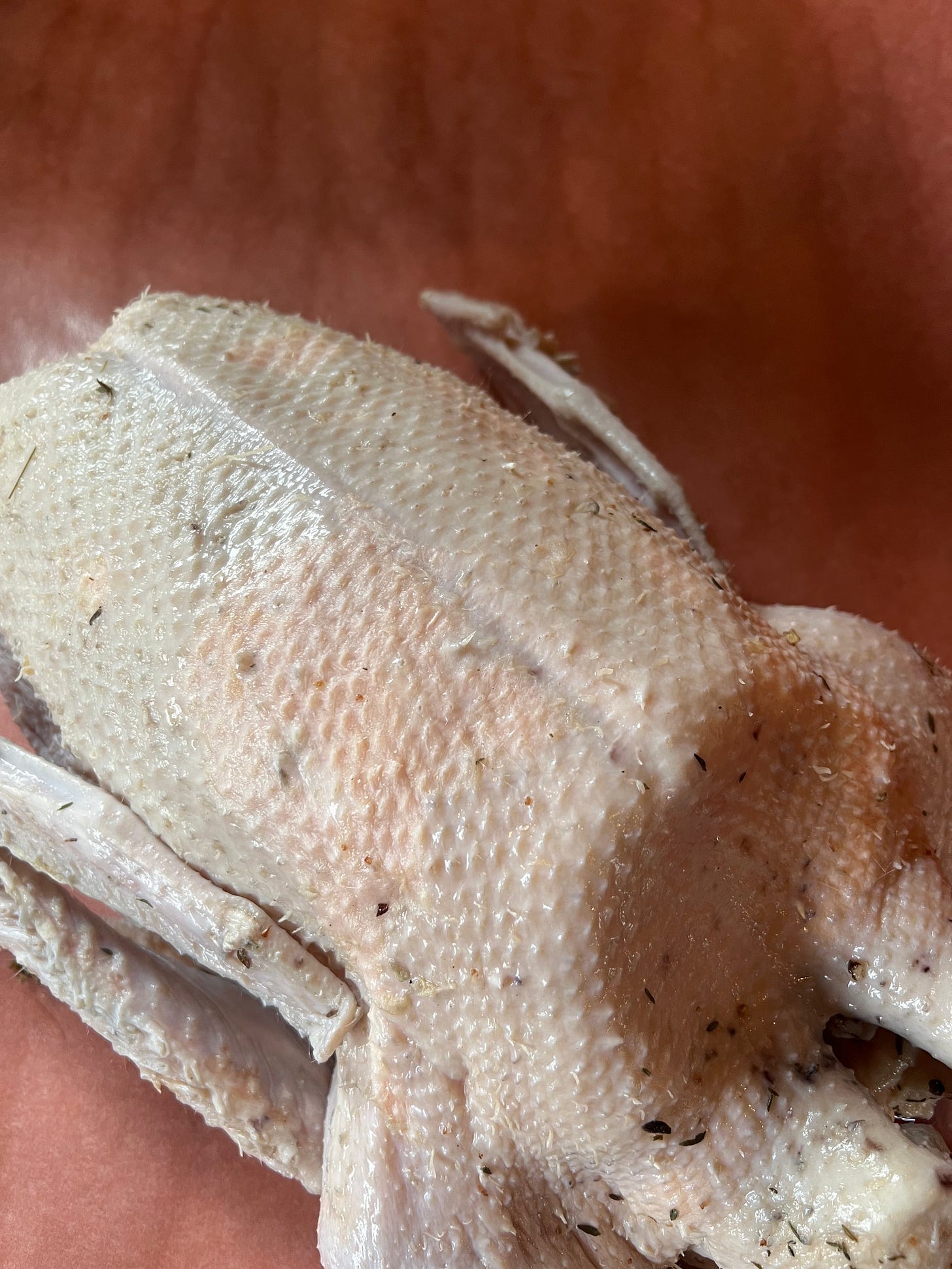
But what about the story of our food? What is the story of our food? Tell me where those strawberries came from. What is the land like there? What birds come for the berries and how do they fend them off? What is the soil like there? What is in the soil that feeds the berries that release their lifeblood on our tongues? Who were the people that tended those fields? Tell me about the hands that picked them, the last to touch them before my own. Were they hands or were they the metal teeth of a machine? Tell me about the farmers that own the farm. Do they like what they do? Who were their ancestors? What grew on that land before food became a commodity and monocultures became profitable?
And the steak. The steak. To whom did it belong? From what body did it come from? Was it AB31056? Ah, yes, “traceability”, the new objective of commercial farming so we might find out which sick animal made us sick. That’s not the story. What is the story of the animal from whence that steak came? Where did it live? To whom was it born? Tell me about the grasses that fed it. Better yet, show me. Connect me. Tell me, did he have a name? Where did he live? How did he die? Who were his buddies in the herd? Don’t protect me from knowing. Don’t try to protect my heart from connection. How in the world can I show an animal the proper gratitude it deserves if it’s just a slab of meat on a plate. A life made trivial by anonymity for the sake of our fragile feelings and the continued profits of a system that grows through the chasms of our separation.
These were the things I was thinking about as I was wrapping our geese in the red butcher paper. We had killed them three days earlier and brined them in homegrown and locally foraged herbs and plants. Maybe some of the plants they ate when they were alive I had picked and used to soak their bodies in as they brined. Either way, they came from the same soil. Same place. That matters, doesn’t it? That resonance? That we eat the organs from those same geese with the geese we eat - does that matter? What label is there for that? The “same goose, same fat, same livers” sticker? Not so catchy. Too visceral. People need buffering with their labels.
I was wrapping the geese, one by one. Looking at their plump bottoms, wiping off any random feathery bits stuck to their skin. I felt great pride in the birds that we raised, supplementing their wild forages with organic feed, the best we could get, because what’s the point in raising less than the best we possibly could. I was thinking about their time with us, those sweet little birds, that grew into big birds so quickly. I was thinking about how tightly they swam together, how bonded they were. How they came into this world, knowing the trail from their home to their feed to their pond. How they roamed like soldiers, tight in their battalions, nibbling at grass tips and the earth’s skin. I thought of their parents now, swimming silently in their pond. That pond, so much bigger. My heart full of sadness and joy. Gratitude seems best able to mix the two.
We lie when we say animals don’t notice when their kin or herd mates are gone. Anyone that says that with conviction is not really observing, doesn’t understand their language. They are sentient beings. They bond, by matter of survival or not, to one another. They are not humans, no. They are animals with their own language and customs and hierarchies. We do these creatures a great disservice by “elevating’ them to the human condition. No need to overlay human traits on them to make them somehow more valuable. They do not “love unconditionally”, as a vegan once yelled at me. To truly value and admire something is to take it for what it is They don’t want to be human. What an insult! They are, when raised to fully express their individual animal characteristics, the full embodiment of whatever they were put here to be. Can we say the same for our species?
On an unseasonably warm Tuesday morning, we let Harold and Maude out of the goose house and left their offspring in. Swimming freely in the pond, calling out to their brood, the two grown geese, veterans now to this system we have developed that keeps the animals, and us, calm and steady, might have known what was happening. Did they know? Come fall, do the parents start anticipating that soon they will lose the goslings they have spent the last three seasons with? No, I don’t think so. Animals are not tortured by endings like humans are. They are fully and completely in every moment of their lives. They waste nothing on thoughts of death. They can’t know what death is. They have no myths amongst them about death. No lies about it being the end of anything. Nothing to steal the fullness of a moment.
Our eleven young geese were carried, one by one, to a killing cone where they were put in upside down. They were bewildered. Light headed. Dead within seconds. Blood sharp and full, fading into trickling droplets. Back into the earth. They were plucked, one by one, by our hands. I reached my hands into their still warm bodies and pulled forth the glistening gems of organs. The emerald of their gallbladders. The deep ruby red livers. The glistening yellow diamonds of their fat pads, sparkling in the sun. I feel rich beyond measure. I am humbled by such bounty. A marvel.
Wrapping the geese later, I am awed by the extraordinary nourishment they have left us. I am keenly aware of the rarity of this beautiful food. Where could I ever buy such food? Food that comes with its story? How can we fill the gap between labels and convenience and the truth that comes from the wholeness of our gifts? It’s pie-in-the-sky, they say. ‘That time in our lives is long gone. It’s production now. We need to feed the world. The geese can’t have ponds. The cows can’t have fields. We’ve progressed, don’t you know?’
But I see that “progress” dismantling, brick by brick. Or is it byte by byte? The cracks can’t be spackled anymore - too deep, too many. In their fissures, little dustings of soil that blew in on the northerly winds feed a seed, dropped by a resting bird, cracked open by the life of sunshine and rain drops. Life in those cracks. Irrepressible, irresistible life. It grows. And so it is with our food. Our food, which is, of course, intimately intertwined with our lives.
We have to ask for the story. We have to go to the people who can provide it. We have to want to know. Not all of us can know, not yet. But for those of us that can, we must. We are in the in-between. The time of reckoning that will bring forth new ways. New ways that might just look something like the old ways. A return to community. A return to handshakes and knowing our neighbours. A return to bartering our labour for a pint of milk, fresh from the cow. The cow whose name you know. We, those of us that can, do this now because someone has to be a part of the reclamation. Someone has to plant the seeds, do the work, reap the harvest so that there will be harvests to reap. If you are among those that can, you must. We are here now, in this time of the dying gasps of the grand experiment of industrialisation, for a reason. And it’s not to sit idly by while it all goes down.
We are waking up to the shortchanging of story for convenience. The lies of the quick and tidy labels are being unveiled. Labels will never substitute for what we really need. What we need is connection. Connection to our food, to each other, to the land that gives us life. Connection to our Creator who is the totality and fullness we hunger for. Connection to our understanding of the meaning of this whole gig we call “life”. That connection is story. The whole story and our place in it. The very stuff that allows us to be here, in strong bodies and minds, must be revered and respected, fought for. We need our food to carry with it the messages of health and beauty, deep into our every cell. Those messages come not just as macros and nutrients, but as the stories we can share with one another. Stories so we can know. Stories so we can be accountable and responsible. Stories to take back what was so lovingly given.



